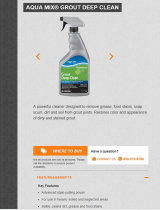
Lifeproof Sierra Wood 6 in. x 24 in.
tile shown. (SKU 1002977053)
TILE CARE &
MAINTENANCE
CARE & MAINTENANCE GUIDE PAGE 1 OF 2
PORCELAIN SLIP RESISTANT TILE GROUT CARE
Routine Care
Porcelain tile should be maintained on a regular and frequent basis to prevent build-up of soil, grease, residue, soap
detergents, sealers, dampness, liquids, etc., to keep the surface clean and lessen slippery conditions.
Glazed porcelain tiles require minimal maintenance. They can be cleaned with clear water and/or a pH neutral liquid cleaner
(soapless). Follow with a clear water rinse and wipe dry to prevent film formation. Any cleaners that leave a film residue are
not recommended and may change the slip resistance performance. Neither sealing nor acid cleaning is recommended for
any Lifeproof glazed porcelain tile.
PORCELAIN SLIP RESISTANT TILE GROUT CARE
Penetrating/Impregnating Sealer
Most tile installations use cementitious grouts. This type of grout should be sealed after installation to prevent the color
from staining. The grout should be sealed with a penetrating/impregnating sealer (often called grout sealers) which does
not contain silicone, as silicone can shorten the useful life of the sealer.
Epoxy grouts, conversely, are chemically cured and acid resistant and, as a result, do not require a sealer. The application
of a good quality penetrating/impregnating sealer into the grout joints of a cementitious grout will not change the
natural color of the grout, but will prevent the penetration of moisture, simplify maintenance, and help prevent staining or
discoloration.
Only the grout needs to be sealed, not glazed floor tiles. Grout can be sealed 72 hours after installation. There are dierent
grades of penetrating/impregnating sealers, therefore the useful life and price will dier between a low quality and high
quality sealer. You may need to reapply the sealer on an annual basis depending on the sealer quality, trac patterns,
and maintenance routine. Some sealers have multiple year warranties for useful life. Refer to the sealer manufacturer’s
warranty, technical & product information for specific details on product installation, useful life, and product applications
(including any warnings) before use.
Grout Maintenance
Neither sealing the grout nor using a 100% Epoxy Grout will guarantee against surface buildup or discoloration of the
grout. Grout needs to be cleaned on a periodic basis to remove any surface buildup. Routine grout cleaning can be
done with a daily concentrated household or commercial cleaner depending on the application.
When heavy duty grout cleaning is required, you will need to use a professional strength Tile & Grout Cleaner
that is capable of removing grease, soap scum, body oil, mildew stains, algae, and synthetic or acrylic waxes
from the grout joints. However, such a product should contain non-polluting chemicals and low volatile organic
compound (VOC) levels.





